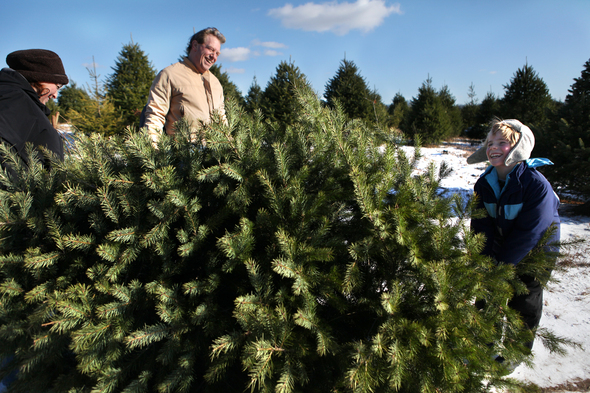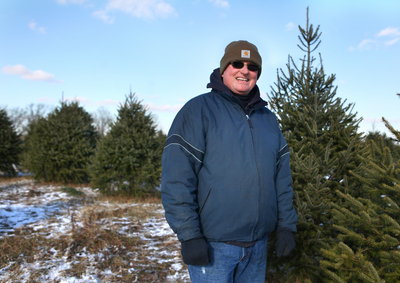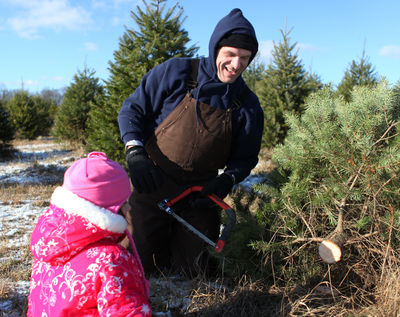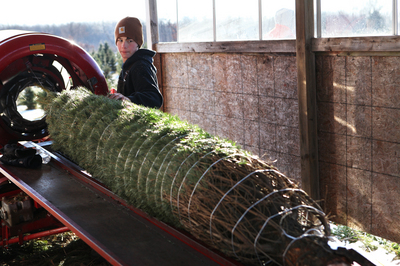Ann Arbor area Christmas tree farms: recession proof but not rain proof?

Ethan Ward, 8, drags a Christmas tree back to his family's car at Arend Tree Farm nearof Chelsea.
Jeff Sainlar I AnnArbor.com
But Arend Tree Farm and a handful of choose-and-cut Christmas tree farms that ring Ann Arbor continue to offer an old-fashioned product in a no-tech environment. They sell not only a fresh cut tree, but also an experience.

Lee Arend, owner of Arend Tree Farm near Chelsea, said his farm has 200,000 trees.
Jeff Sainlar I AnnArbor.com

Derek Webb shares a laugh with daughter Hannah, 8, after cutting down a tree at Arend Tree Farm near Chelsea.
Jeff Sainlar I AnnArbor.com
Michigan's Christmas tree growing industry
- Michigan is the third largest grower of Christmas trees, behind Oregon and North Carolina.
- The popular Fraser fir comes from North Carolina but will grow in Michigan, given the right soil conditions and water.
- It takes about eight years to grow a tree ready for harvest.
- People are putting up their trees earlier than ever, which drives the demand for trees with lengthy needle retention. “Now, people are buying their tree before Thanksgiving,” Gray said. “They want to stretch the season.”
- Michigan produces an estimated three million Christmas trees a year with a wholesale value of $40 million.
- One out of five fresh trees sold in the U.S. are choose and cut.
And while wholesale Christmas tree growers have seen a drop in sales in recent years, choose-and-cut growers are holding steady or even seeing modest growth, said Marsha Gray, executive director of the Howell-based Michigan Christmas Tree Association, which represents 700 Michigan Christmas tree farms. It follows the growth in "agritourism," she said. “Whether it’s a pumpkin patch or an apple orchard or cutting your own tree, people are looking for more than a pumpkin, apples or a tree. They’re looking for fun.”
The Friday after Thanksgiving was one of the strongest starts ever for Michigan choose-and-cut growers, Gray said. But the rain that followed subsequent weekends put a damper on sales: While consumers don’t mind the cold or a dusting of snow, rain and mud keep them away.
It’s too early to judge the season, said Arend, whose 350-acre tree farm west of Chelsea is one of the largest in southern Michigan. Unlike most other choose-and-cut operations, Arend's operation is a full-time business that has supported his family for four generations.
It’s not just the rainy weekends that have hurt sales this year, said Ken Judkins, whose family owns Braun’s Trees, a 50-acre farm on Warren Road in Ann Arbor. “The day Michigan played Ohio State was really slow,” he said.
While the weather has an impact, tree cutting is somewhat recession-proof, he said. “People still want to get a Christmas tree. But if it rains, people will stay home and go to Home Depot to get a tree," he said.
Arend agreed that the economy had less impact than weather or demographics. Sales peaked in the late 1980s and early 1990s.
“They were bumper years when there were a lot of new kids,” Arend said. But as those kids grew older, sales fell. Now, they are beginning to rebound. The green movement has helped.

Joey Spence, 13, helps prepare a tree for its new owner at the Arend Tree Farm.
Jeff Sainlar I AnnArbor.com
“I just heard that a conservation group was encouraging people to cut live trees, that it’s better for the environment than buying an artificial tree that’s made in China and ends up un the landfill,” Arend said. “And it adds to the economy of the state.”
Fraser fir continues to be the most popular species, area tree farms reported, pushing formerly ubiquitous Scotch pine from the stage beginning in the 1980s. Because it takes eight years to respond to a change in demand — that’s how long it takes to grow a Christmas tree to harvest size — growers need to keep an eye on trends. Braun’s first seedlings in 1987 included pine, but they were quickly replaced exclusively by fir, Judkins said. Braun’s has found other ways to respond to changing demand: The Noble fir, popular in the northwest where it grows at an altitude of 6,000 feet, is catching on. Braun for the past four years has bought about 40 pre-cut Noble fir trees from the northwest. Susan Urquhart of Urquhart’s Tree Farm near Dexter was quick to respond to the demand for Fraser fir when she first started and it now represents 40 percent of her sales. And she is looking toward the future, experimenting with hybrids, including a cross of a Fraser fir with Balsam, producing a fuller tree than its parents. She also planted a Korean fir and Balsam hybrid.
Urquhart Tree Farm, which has grown almost every year since it began selling you-cut trees more than two decades ago, sells about 3,000 trees each season and transplants about 11,500 seedlings each spring.
Part of that growth comes from diversification. More choose-and-cut operations are adding other products and services to their operations, said Rick Dungey, spokesman for the National Christmas Tree Association, from ornaments and wreaths to three-foot tabletop trees.
“It’s no longer a guy sitting in the back of a truck and handing someone an axe or a hatchet and saying “go over there,”’ Urquhart said.
At Urquhart’s, each customer is handed a map of the tree field, there’s a hayride and there’s a shaker and a baler. And there are ornaments, wreaths and roping inside a gift shop, converted from an old hip-roof barn in 2000.
Janet Miller is a freelance reporter for AnnArbor.com.


Comments
Tesla
Sun, Dec 18, 2011 : 3:16 p.m.
The main noticeable difference between these Fir varieties vs the old Scotch Pines is that the Firs don't have that old school Christmas Pine smell. Frankly they don't smell at all and the ambiance is less than it used to be. Progress?
paul wiener
Fri, Dec 16, 2011 : 5:12 p.m.
The same trees that the stores named in this article are selling are priced at $90 at English Gardens and other similar "garden centers." Whoever supplies these stores and manages them should be ashamed and avoided. They rip off the Christmas spirit, and discourage the sale of and the interest in buying natural trees.
jns131
Fri, Dec 16, 2011 : 4:04 p.m.
My family avoids real trees at all cost. The mess they make is horrible. Give me a nice artificial tree any day of the week with my pine scented candle to go with it. Great article. But nope, real trees are not for me.
brimble
Fri, Dec 16, 2011 : 1:52 p.m.
My family has gotten a tree from Urquhart's every year since we moved to Michigan. This is not unlike shopping at the Farmer's Market -- buying local keeps money circulating in our local economy, and cutting a live tree is very environmentally sustainable as the land gets replanted and the tree itself can be used for mulch or compost. Plus, the scent of a real tree is one our favorite parts of the Christmas season!
Soothslayer
Fri, Dec 16, 2011 : 11:48 a.m.
I've been going Arend's by Chelsea for the past 7 years. You can tell they care. It's a great family owned operation and the experience with the horse drawn hayrides can't be beat. They have a huge selection and two areas to get various types of trees from. Theres a 150 year old church you can stop by on certain days to get homemade doughnuts, hot cocoa and other holiday items. A great experience!